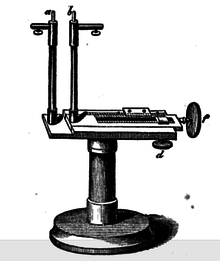Spark micrometer

The spark micrometer, also known as a Riess micrometer[1] was a device used by 19th century physicists to measure potential in an electric circuit. It was developed principally by German physicist Peter Riess. Its manner of operation was that the distance between two electrodes when a spark just jumped across a gap was proportional to the total charge on the electrodes, and thus the potential difference between the points where the electrodes were attached. In other words, distance measured was proportional to potential. It was while using a spark micrometer that Heinrich Hertz noticed that the spark could be created even when only one electrode was attached.[2] This led him on a chain of investigation whereby he proved Maxwell's prediction that electromagnetic field propagated with the properties of light, and thus that light was merely a special case of general electromagnetic radiation.[1]
References
- 1 2 The creation of scientific effects : Heinrich Hertz and electric waves. Chicago: University of Chicago Press. 1994. ISBN 9780226078915. Retrieved September 25, 2015.
- ↑ Annual Report Smithsonian Institution. Washington: A.O.P. Nicholson. 1857. Retrieved September 25, 2015.